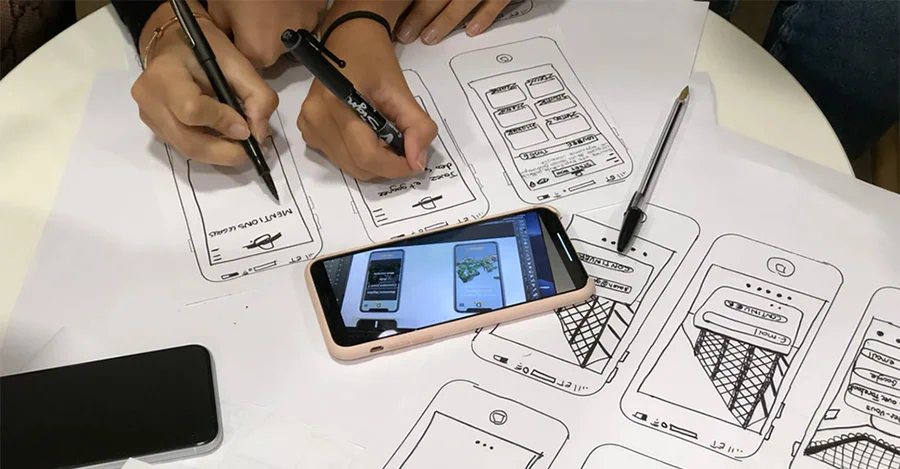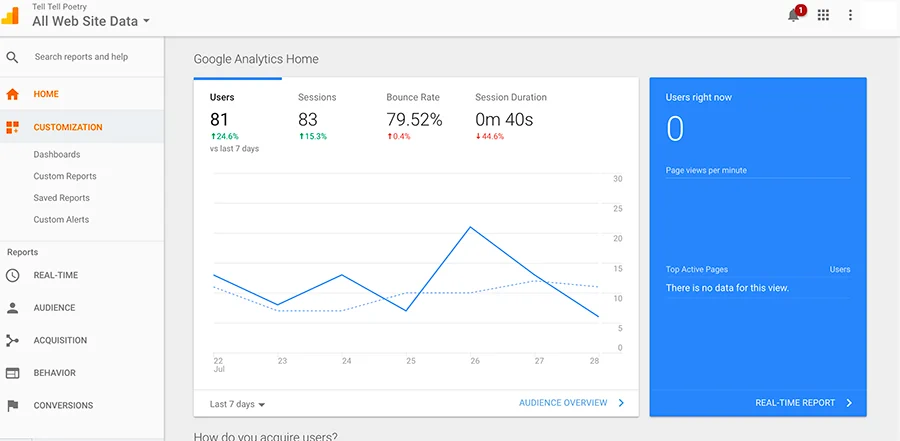What is the Psychology of Your Web Visitors?
Color is one of the most powerful tools in marketing, and it’s essential to understand what colors work best for each type of visitor. Bright colors can be great for catching attention, while softer colors are better at conveying a sense of trustworthiness. Darker colors are often used as a secondary color choice or to highlight key phrases.
When planning a website, it’s essential to understand searcher intent and what potential visitors might be looking for. An experienced marketing adviser can help you develop effective content marketing strategies that will provide clarity and direction to hundreds of users searching for specific information on search engines daily.
By taking into account the psychology of your web visitors, you can create an effective color scheme that appeals to first-time visitors and those who have visited before. Your choice of colors may also influence your favorite website colors, so paying attention to these details when creating your site is essential.

Why Should You Care About the Psychology of Your Web Visitors?
Understanding the psychology of your web visitors is essential for creating successful websites. Knowing what colors, phrases, and design elements appeal to different types of visitors can help you create a website that will capture the attention of potential customers, increase engagement, and ultimately result in more conversions.
By taking into account the psychology of your web visitors and using it to inform your web design decisions, you can ensure that your website looks and functions in a way that appeals to its target audience.
This understanding can help you craft content that resonates with your visitors and encourages them to take action. Ultimately, paying attention to the psychology of your web visitors will help you create an effective website that meets their needs and generates significant returns for your business.

Understanding Searcher Intent
When marketing your website, understanding searcher intent is key. Searcher intent is the goal behind a person’s search query and can range from looking for information to make a purchase.
By understanding searcher intent, you’ll be able to craft content that meets visitors’ needs and encourages them to take action. You can also use this knowledge to create a more efficient marketing strategy by focusing on keywords that are most likely to lead to conversions.
You can use it as a guide when creating calls to action that will help direct visitors toward taking the desired action. Understanding searcher intent can clarify hundreds of marketing decisions and ultimately result in more conversions for your business.
What is Searcher Intent?
Searcher intent refers to the goal behind an individual’s search query when visiting a website. It is the purpose of why they are searching and can range from looking for information, finding a product or service, or making a purchase.
By understanding searcher intent, businesses can create content that meets the needs of their visitors and encourages them to take action. Moreover, this knowledge can be used to craft more effective marketing strategies by targeting keywords that are likely to lead to conversions.
It can also guide businesses in creating effective calls-to-action, which will help direct visitors toward taking the desired action. Understanding searcher intent is an invaluable tool for any business as it provides clarity in hundreds of marketing decisions and ultimately leads to more conversions for the business.
How to Optimize for Searcher Intent?
Optimizing for searcher intent involves understanding the goal of your target market and then creating content that meets their needs. One way to do this is by tracking what keywords are being used to find your website and targeting them in your marketing efforts.
Consider using long-tail phrases which are more specific and likely to lead to conversions. Furthermore, adjust your color scheme, calls-to-action, and other design elements based on the type of visitor you are trying to attract.
For example, use brighter colors for first-time visitors and softer colors for potential customers who have visited before. Finally, be sure to use key phrases that clearly explain what it is you are offering so that visitors can easily find what they are looking for. By optimizing for searcher intent, businesses can ensure they have a clear message which will help draw in more customers.
What Factors Determine Searcher Intent?
Searcher intent is important in determining how a website or product is marketed. Factors such as the type of visitor, their goals for visiting the website, and the keywords used to search for it all contribute to searcher intent.
Search engines use algorithms that examine hundreds of marketing decisions to determine what content should be presented to potential visitors. These factors include the clarity of content and key phrases used within it, color choices, calls-to-action, white space, use of videos or images, and more.
It is also important to consider different types of visitors when designing a website and tailoring its colors and content.
For instance, while bright colors may appeal to first-time visitors who are just learning about a company’s product or service, softer colors may be more attractive to customers who have already made purchases in the past.
Ultimately, understanding searcher intent can help businesses make marketing decisions to attract potential customers and meet their needs.
Identifying Your Target Market
Identifying your target market is essential for any business. Without a clear understanding of your customers, you won’t be able to create a successful marketing strategy. To determine your target market, consider factors such as age, gender, income level, location, interests, and needs.
You should evaluate how potential customers interact with the web and their browsing behaviors. For example, what type of content do they prefer? What sites do they visit the most? This can help guide content creation and tailor it to the interests of your target audience.
Focus on creating clarity in all customer communications so that hundreds of people understand your message. Finally, consider using color psychology when designing your website or marketing materials. A well-thought-out color scheme can make a big difference in how customers view your brand and products. Identifying your target market will help you create an effective marketing strategy that appeals to potential customers and meets their needs while increasing sales.
Who Are Your Target Market?
Understanding your target market is key to creating a successful marketing strategy. To determine your target market, consider factors such as age, gender, income level, location, interests, and needs.
It is important to understand how potential customers interact with the web and their browsing behaviors. Knowing what type of content they prefer and which sites they visit the most will help guide content creation and tailor it to the interests of your target audience.
It’s also essential that all communications are clear so that searchers can easily understand what you’re trying to communicate.
Finally, consider using color psychology when designing your website or marketing materials; different colors evoke different emotions from visitors and can have a powerful impact on how people view your brand.
Identifying your target market is essential to any business plan that will increase sales by understanding what potential customers want and need.
Color Scheme and Its Impact on Visitor Experience
Color is an important factor in the design of any website. The color scheme chosen for a website can have a major impact on visitors’ experience, as it affects their emotions and reactions to the content.
Choosing the right colors can create clarity and help draw attention to important elements on the page. It is also important to consider how different colors will look on different devices, as this can affect readability.
Bright, vibrant colors are often used to grab attention and draw users into a website, while softer colors give off a more calming atmosphere. Different combinations of primary, secondary, and accent colors can be used to create a unique color scheme that reflects your brand identity or desired mood. When designing for web visitors, it is
What is Color Psychology and Its Role in Designing Websites?
It’s essential to consider how color choices will affect them emotionally.
Color psychology studies how people perceive color and how it affects their behavior. It plays a key role in website design, as different colors evoke different emotions in visitors. For example, blue is often used to promote trust and security, while yellow encourages optimism and energy.
Different colors can also be used to create a certain atmosphere or mood; for example, warm colors such as reds and oranges can evoke passion and excitement, while cooler hues such as blues and greens often give off a calming vibe.
When designing for web visitors, it is important to consider how the chosen color scheme will affect them emotionally. By considering the psychology of color when designing websites, designers can create an experience that meets their target audience’s needs.
How Different Colors Affect Visitor Experience Differently?
Color is an important element of web design, as different colors evoke different emotions in visitors. When creating a website, it is essential to consider how the chosen color scheme will affect them emotionally.
For example, warm colors such as reds and oranges can create feelings of passion and excitement, while cooler hues such as blues and greens can give off a calming vibe. Bright colors are often associated with energy, whereas softer colors usually create a soothing atmosphere.
Furthermore, white space can be used to add clarity to hundreds of marketing decisions made by the website’s owners. Calls to action should also be considered when choosing colors. Key phrases that visitors will likely search for should be highlighted with brighter colors to draw their attention.
By considering the psychology of color when designing websites, designers can create an experience that meets their target market’s needs and encourages potential visitors to stay longer on the page.
Which Colors are Most Effective in Enhancing the Visitor Experience?
Colors are an important part of web design as they can either enhance or detract from the user experience. Knowing which colors work best for your website is essential to engaging visitors and creating a positive first impression.
Generally, the best colors to use are those that evoke feelings of trust and security, such as blues and greens. However, it is also important to consider the type of visitor you are targeting. For example, brighter colors may suit younger audiences who respond better to bolder tones.
Using secondary colors in combination with primary ones can add visual interest and depth to a page. Researching your target market’s color preferences is beneficial before deciding on color schemes. You can create a better website that meets their expectations by considering their tastes and needs.
Bright Colors vs. Soft Colors: Which Should You Choose for Your Website?
When it comes to choosing colors for your website, there are two main options: bright and vibrant colors or softer, more muted tones. Bright colors are often used to draw attention and create a sense of energy and excitement.
However, they can also be overwhelming if overused, so it is important to use them sparingly. Soft colors tend to evoke feelings of tranquility and calmness, making them perfect for websites that want to convey a sense of serenity.
It is best to use a combination of both bright and soft colors; this will help create visual interest without being too garish or distracting. Ultimately, the decision about which type of color scheme to choose should be based on the purpose of the website, its target audience, and the overall design aesthetic.

